Manny & Mozart
Pianist Emanuel Ax was performing an all Mozart program with the Orpheus Chamber Orchestra at Carnegie Hall tonight, celebrating the 250th anniversary of the birth of Wolfgang Amadeus Mozart (1756–1791) and the 30th anniversary of Ax’s first collaboration with the conductorless ensemble.
Ax first came to the public’s attention in 1974 when, at 25, he won the first Arthur Rubinstein International Piano Competition in Tel Aviv. Since that auspicious start, Ax has gone on to win numerous awards, including the Avery Fisher Career Grant (awarded annually since 1982 to outstanding solo instrumentalists) and several Grammys: two for his solo recordings and five for collaborations with Yo-Yo Ma, Jaime Laredo, and Isaac Stern.
That afternoon, I placed a call to the Carnegie Hall Box Office and was surprised to learn that there were still seats available to that night’s performance. Better still, they were offering last minute $10 (cash only) tickets. At that price, it didn’t even matter where in the Hall the seats were: we were going to Carnegie Hall!
SYB left the office early to pick up the tickets. After he and I met up for a quick pre-concert bite — one booth over from Atoosa Rubenstein — it was off for an evening of Mozart.
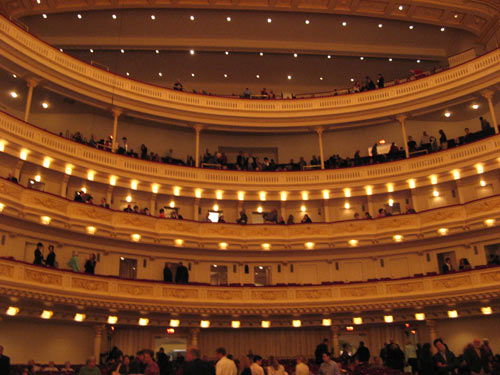
I don’t know why, I don’t know how… but here we are again: second row center! From our seats, we were close enough to see the flying hammers reflected in the propped, glossy lid of the grand Steinway.
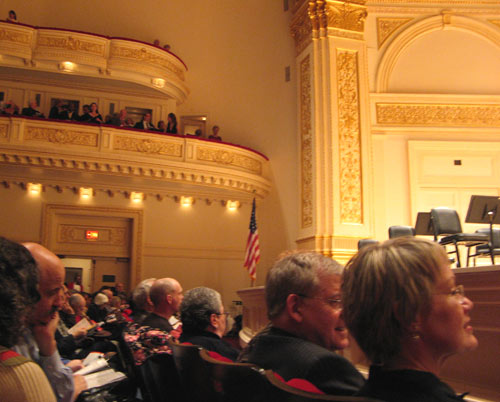
Ax’s playing was “fluid, elegant and refined,” as the New York Times noted in their glowing review of the concert. I was intrigued by how the leaderless Orpheus managed to keep their playing even and well-tempered, especially during some of the pieces’ more fluid, running segments. A different core group shapes each piece, shifting seating assignments and providing cues for their respective sections. The process requires almost twice as many rehearsals, but allows the individual ensemble players opportunities for input not possible in a conductored grouping.
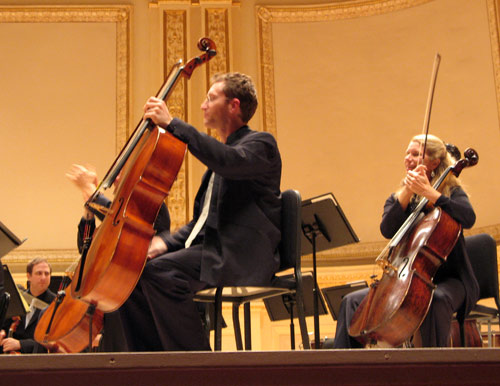
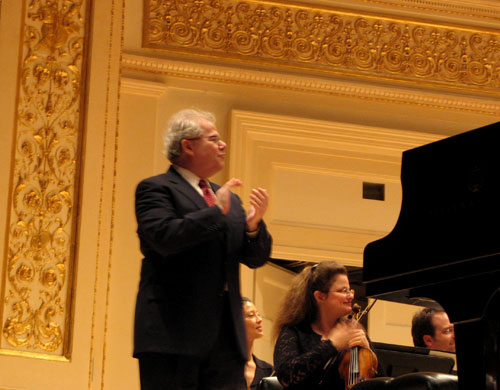
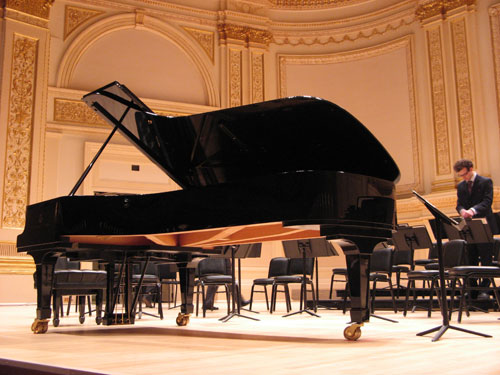
Beginning on Friday, October 13, and through January 7, 2007, the Morgan Library is also celebrating the 250th anniversary of Mozart’s birth with an exhibition entitled “Mozart at 250: A Celebration,” tracing the great composer’s life through manuscripts, letters, and first editions of his works. Works among the always impressive collection include tonight’s “Haffner” Symphony, K. 385 [1782–83], in the velvet and silver case in which it was housed when it was presented to King Ludwig II of Bavaria in 1865. I remember this from the last time I was in the manuscript room, a couple of months ago. Also on display:
Other manuscripts from the Vienna years include those of the somber Fugue for Two Pianos in C Minor, K. 426, Mozart’s only keyboard fugue of any distinction; two of his best-known piano concertos — in C, K. 467, and D (“Coronation”), K. 537; Der Schauspieldirektor (The Impresario), the only manuscript of a Mozart opera in this country; the Piano Rondo in D, K. 485, known to piano students around the world; the Horn Concerto in E-flat, K. 495, written in four different colors of ink; and the arrangement for voice, violin, and piano of Cherubino’s aria “Non so più cosa son” from Le nozze di Figaro (The Marriage of Figaro), the only complete arrangement of an operatic number Mozart is known to have made.
The exhibition ends with the exceedingly rare first edition of the Requiem, K. 626, left incomplete at Mozart’s death.
I’m constantly amazed by the sheer depth of Mr. Morgan’s collection. Definitely checking this out.
A case of Russian
Having missed last week’s class, it was up to me to review on my own some of the materials we covered last Wednesday.
In Russian, the instrumental case (tvorítel’nyj padézh) is used to mark the means by which an action is done. The “instrument” can be a physical entity (“by car,” “with friends” or “with a pen“) or more abstract (“with enthusiasm“). It is also used to denote spatial relationships (behind, between, under), a time during which an action occurs (“in the evenings“), a change of state or status (“After eating all those apricots, I became ill“), or to emphasize a profession (“She works as a doctor.”) All this I ascertained from the supplemental Russian study guide I ordered through Amazon.com this week. Because the topic wasn’t covered in the textbook we’re using for the course. Yes, this class is proving to be quite a challenge.
Someday… I want to read Tolstoy in the original Russian.
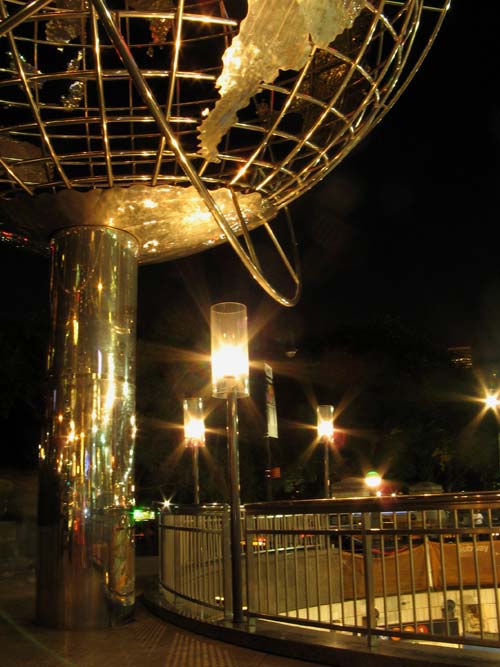
“The aim of an artist is not to decide a question indisputably, but to compel us to love life in all its countless, inexhaustible manifestations.”
— Lev Nikolayevich Tolstoy (1865)
MOVE FOR AIDS at Public
On Tuesday night, M and I attended Public and AvroKO’s preview showcase of acclaimed Australian photographer (and yoga enthusiast) James Houston’s latest artistic endeavor: MOVE FOR AIDS — for which Houston brought together over fifty of America’s leading dancers in a photography essay created to raise awareness and funds for AIDS charities.
The project incorporates the MOVE FOR AIDS book, published by DUMBO-based powerHouse Books (it’s Houston’s fourth, and the result of a collaboration with design house Hugo Boss), photographic exhibitions, a special documentary on the shooting of MOVE, and dance performances by some of the world’s leading dance companies to launch the project around the world. Houston will be donating all author royalties from book sales of MOVE FOR AIDS to DRA (Dancers Responding to AIDS).
Houston’s background as a sculptor is evident in his shaping of the dancers’ sinewy forms — some of which may not be SFW. The full exhibition will be on view at Manhattan’s MILK Gallery from October 24 to October 29, 2006. After the New York launch, MOVE FOR AIDS will continue on to London to benefit the Elton John AIDS Foundation, and then to Australia to coincide with World AIDS Awareness Week. The exhibition preview was held in the brightly lit jewelbox gallery adjacent to the restaurant, and this night the overflow of attendees lined up along the restaurant’s entrance staircase and spilled out to the sidewalk in front.
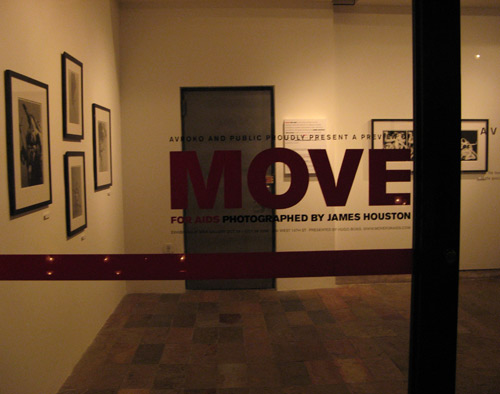
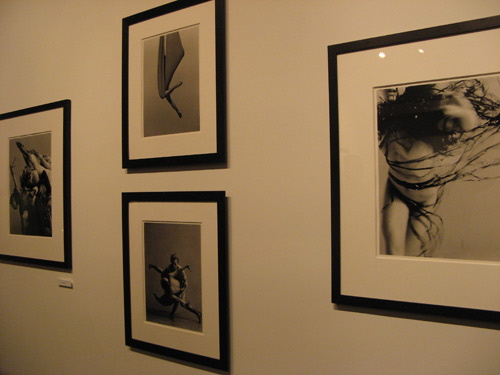
M and I snaked our way in through the room and after touring the small selection of photographs on display (which took all of ten minutes), we took our glasses of Shiraz inside the dining room for dinner. The terrace facing Elizabeth Street, where we were seated last time, was closed off on this brisk night.
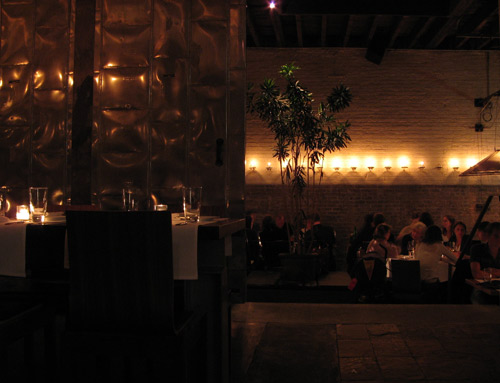
Amuse-bouche, which has been described as “little bites of food to amuse the mouth, invigorate the palate, and whet the appetite.” Indeed! Soft-cooked quail egg, atop an eel cabbage slaw.
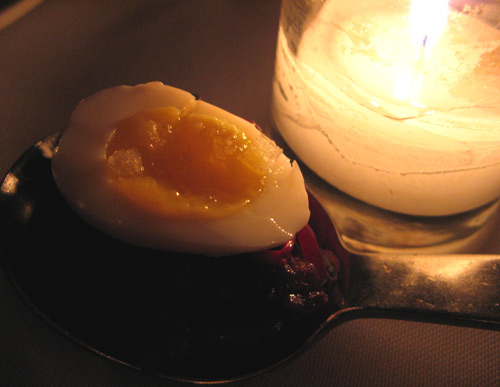
New Zealand snapper on wasabi-boniato mash with poached conch, pickled ginger, and yao choy:
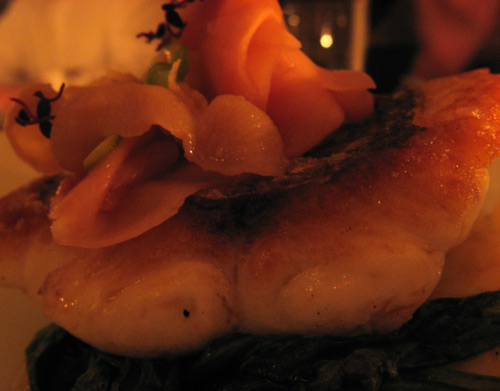
Our meal was accompanied by a fine pinot noir, and finished off with Public’s ultra-rich, ultra-dense chocolate fudge cake, served with a stick of salty, sweet peanut brittle and a scoop of Guinness ice cream. M is still waiting for her favorite “Hokey pokey ice cream with a ginger snap” to make its return to the dinner menu. (Currently only available for brunch.)
Comforting to know that even after she defected to the other side of the river, my (lesbian) friend can still make time for us New Yorkers… even as she tries to recruit a select few over to the Garden State.
| S | M | T | W | T | F | S |
|---|---|---|---|---|---|---|
| 1 | 2 | |||||
| 3 | 4 | 5 | 6 | 7 | 8 | 9 |
| 10 | 11 | 12 | 13 | 14 | 15 | 16 |
| 17 | 18 | 19 | 20 | 21 | 22 | 23 |
| 24 | 25 | 26 | 27 | 28 | 29 | 30 |
Search
Popular Tags
Categories
Archive
- July 2010
- July 2009
- January 2009
- November 2008
- September 2008
- August 2008
- July 2008
- June 2008
- May 2008
- April 2008
- March 2008
- February 2008
- January 2008
- December 2007
- November 2007
- October 2007
- September 2007
- August 2007
- July 2007
- June 2007
- May 2007
- April 2007
- March 2007
- February 2007
- January 2007
- December 2006
- November 2006
- October 2006
- September 2006
- August 2006
- July 2006
- June 2006